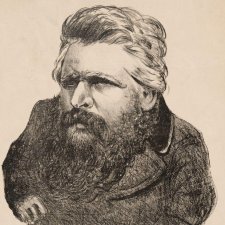Temporary road closures will be in place around the Gallery until 11 March during the Enlighten Festival.
James George Beaney (1828–1891), doctor and philanthropist, completed an apprenticeship to a surgeon in his home town of Canterbury, Kent, before leaving to study medicine at the University of Edinburgh. There, he is thought to have contracted tuberculosis, initiating a health-related sojourn in Victoria in 1852–53. Eventually completing his studies as planned, he became an army doctor, serving in Gibraltar and the Crimea before visiting America as a surgeon on immigrant ships. He returned to Melbourne in 1857, acquired a practice in 1858, and became an honorary surgeon to the Melbourne Hospital in 1860, the same year in which he was elected a fellow of the Royal College of Surgeons. By this time, he had authored one of the first medical textbooks published in Australia. A pioneering paediatrician, anaesthetist, proponent of family planning and expert in the treatment of venereal disease, Beaney was a bold, even reckless, surgeon, on occasion undertaking risky procedures with success. But he was also accused of incompetence and was shunned by many in the medical fraternity for his outrageous flamboyance, said to have extended to consuming his favourite tipple, champagne, while performing operations before invited guests (who were also imbibing). His taste for jewels (which he wore while operating) earned him the nickname ‘Diamond Jim’ and made him a target for caricaturists. In 1866, Beaney faced trial – twice – for the murder of a barmaid alleged to have died as a result of an ‘illegal operation’; he was acquitted. Despite such scandals, he was admitted to the degree of MD by the University of Melbourne and St Andrews University; and from 1883 until his death he was the member for North Yarra on the Legislative Council. Among the various organisations and charities to benefit from his substantial estate were medical schools in Melbourne and London; several hospitals; and the city of Canterbury, to which he bequeathed £10,000 for the establishment of the ‘Beaney Institute for the Education of the Working Man’ (now the Beaney House of Art and Knowledge), which opened in 1897.
Collection: National Portrait Gallery
Purchased 2016



On one level The Companion talks about the most famous and frontline Australians, but on another it tells us about ourselves.



Joanna Gilmour on Tom Durkin playing with Melbourne's manhood.



Visit us, learn with us, support us or work with us! Here’s a range of information about planning your visit, our history and more!